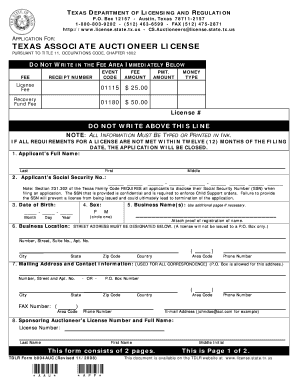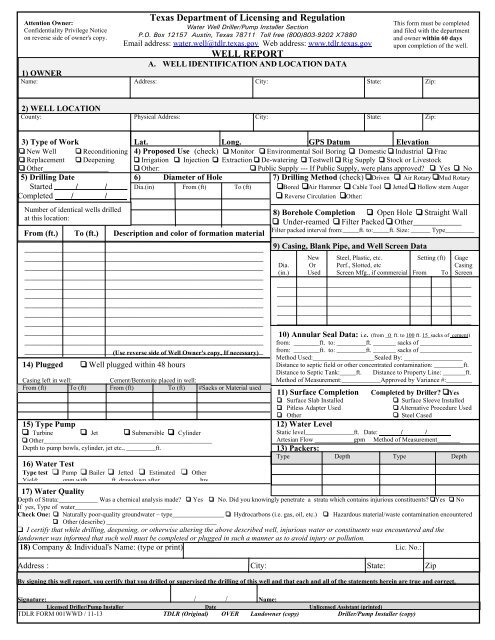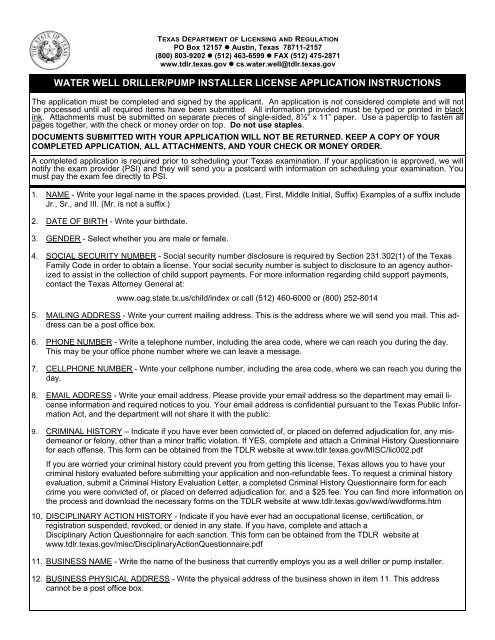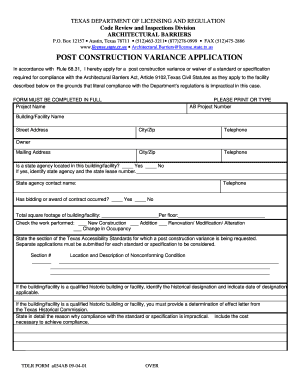Texas Department Of Licensing And Regulation Form
Introduction
Welcome to our guide on the Texas Department of Licensing and Regulation Form. In this post, we will provide you with all the essential information you need to know about this form. Whether you're a new driver or an experienced one, understanding and filling out this form correctly is essential to abide by the regulations set by the Texas Department of Licensing and Regulation (TDLR).
Subheading 1: What is the Texas Department of Licensing and Regulation Form?
The Texas Department of Licensing and Regulation Form is a document required by the TDLR for various purposes related to driver's education and regulation. It serves as a way to collect necessary information from individuals, such as personal details, driving history, and any other relevant information that helps the TDLR ensure compliance with state laws.

If you are planning to apply for a driver's license or renew your existing license in the state of Texas, you will need to complete this form accurately and submit it to the TDLR. Filling out the form incorrectly or providing inaccurate information could lead to delays in processing your application or even result in rejection.
Subheading 2: Understanding the Sections of the Form
The Texas Department of Licensing and Regulation Form consists of several sections, each designed to collect specific information. Here are a few key sections you need to be familiar with:
Section 1: Personal Information
This section requires you to provide your basic personal details, including your full name, address, date of birth, and contact information. Make sure to double-check the accuracy of the information before submitting the form to avoid any issues in processing.
Section 2: Driver's License Information
In this section, you will need to provide details about your current driver's license, if applicable. This includes the license number, issue date, and expiration date. If you are applying for a new driver's license, you can leave this section blank.
Section 3: Driving History
Here, you will need to disclose your driving history for the past few years. This includes any traffic violations, accidents, or suspensions of your driver's license. Honesty is crucial in this section, as providing false information can lead to serious consequences.

Ensure that you provide accurate information and provide any additional documentation or supporting evidence if required.
Section 4: Medical Disclosure
If you have any medical conditions that may affect your ability to drive safely, you must disclose them in this section. Examples include vision impairments, disabilities, or any other condition that could impact your driving abilities. It is important to disclose this information for your safety and the safety of others on the road.
Subheading 3: How to Fill Out the Texas Department of Licensing and Regulation Form
Filling out the Texas Department of Licensing and Regulation Form may seem daunting at first, but with a step-by-step approach, it becomes much simpler. Here's a guide on how to fill out the form correctly:
Step 1: Download the Form
To begin, download the official Texas Department of Licensing and Regulation Form from the TDLR website or any authorized sources. Ensure that you have the latest version of the form to avoid any discrepancies.
Step 2: Read the Instructions
Before filling out the form, carefully read through the instructions provided. Understanding the instructions will help you provide accurate information and prevent any errors.
Step 3: Gather Necessary Information
Collect all the required information, such as your personal details, driver's license information (if applicable), driving history, and medical disclosure details. Having this information readily available will make the form filling process smoother.
Step 4: Complete Each Section
Start by completing the personal information section, ensuring that you provide accurate and up-to-date details. Move on to the subsequent sections, filling them out accordingly.
Step 5: Review and Proofread
Once you've filled out all the sections, take some time to review the form. Check for any errors, missing information, or inconsistencies. It is essential to proofread the form to ensure its accuracy.
Step 6: Sign and Submit
Before submitting the form, sign it in the designated area. Make a copy for your records and send the original form to the TDLR according to their submission guidelines. It's recommended to send the form through a secure and trackable method to ensure its safe delivery.
FAQs (Frequently Asked Questions)
Q1: Can I fill out the Texas Department of Licensing and Regulation Form online?
A1: Yes, the TDLR provides an online portal where you can fill out the form digitally. However, it is essential to ensure that your digital submission meets all the requirements set by the TDLR. If you have any doubts, it's always advisable to consult their official guidelines or seek assistance from authorized personnel.
Q2: What happens if I provide inaccurate information on the form?
A2: Providing inaccurate information on the Texas Department of Licensing and Regulation Form can lead to various consequences. It may result in the rejection of your application, delays in processing, or even legal repercussions. It is always best to be honest and provide accurate information to avoid any complications.
Q3: How long does it take to process the Texas Department of Licensing and Regulation Form?
A3: The processing time for the Texas Department of Licensing and Regulation Form may vary depending on various factors, such as the volume of applications and the accuracy of the submitted form. It is best to check the TDLR's official website or contact their customer service for more information on the current processing times.
Conclusion
The Texas Department of Licensing and Regulation Form is a crucial document for individuals applying for or renewing their driver's license in Texas. It is essential to understand the different sections and provide accurate information to ensure compliance with state regulations. By following the steps outlined in this guide and being aware of the frequently asked questions, you'll be well-prepared to handle this form effectively. Remember, providing accurate information and being honest is paramount to maintain safe roads for everyone.
Texas Department Of Licensing And Regulation WELL REPORT
 Image Source : www.yumpu.com
Image Source : www.yumpu.com Drivers Ed Packet From Texas Department Of Licensing And Regulation
 Image Source : www.signnow.com
Image Source : www.signnow.com TDLR Licensees | FosterDanowsky, Austin, Texas
 Image Source : fosterdanowsky.com
Image Source : fosterdanowsky.com Texas Department Of Licensing And Regulation Personal Information Form
 Image Source : www.formsbank.com
Image Source : www.formsbank.com texas regulation department licensing form printable pdf personal information
Texas Department Of Licensing And Regulation
 Image Source : www.texaspolicy.com
Image Source : www.texaspolicy.com Fillable Online Chandleraz Date Prepared December 14,2006 - Chandleraz
 Image Source : www.pdffiller.com
Image Source : www.pdffiller.com Form #015 WWD - Texas Department Of Licensing And Regulation
 Image Source : www.yumpu.com
Image Source : www.yumpu.com Texas Department Of Licensing And Regulation Form - Fill Online
 Image Source : www.pdffiller.com
Image Source : www.pdffiller.com Form #015 wwd. Texas department of licensing and regulation. Texas department of licensing and regulation personal information form. Tdlr licensees. Texas department of licensing and regulation form